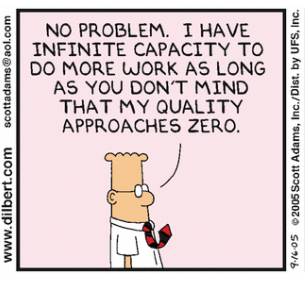Data, data, data. I love data. Way too much. More than is normal. I’ve written about it. Given workshop and conference sessions on it. I’ve extolled the virtues of high, accountable expectations around Help Desk management more times than I care to admit. A technical college even trusts me to teach students about IT Support Desk Analysis. What if this fixation, while a noble notion, is an unhealthy obsession that can lead to technical debt issues down the road?
The 20th Century management and quality oracle W. Edwards Deming wrote at length about the evils to an organization of quotas – I paraphrase here “if you give someone a hard account to work with and it takes them a long time to do good work, why would you punish them for not meeting some arbitrary number? What about the worker that is tasked easy accounts and finishes their quota in 6 hours? Should they sit idle for the remainder of their shift?”
Understanding technical debt
Perhaps all these years I’ve been focusing on unhealthy means of how to measure quality service. Unhealthy means that have led to longer-term challenges in my organization.
I’ll start this attempt at an allegory with the picture below.

This Wisconsin manufacturer needed to modernize its IT infrastructure to support rapid business growth.
Discover what they did
What happens when something goes pop in this wiring rack? How did it ever get this way? How many one-off wiring runs were just slammed into the switch – not to be bothered with a patch panel (I can see 4 in this picture)? I’ve seen this type of rack in more than one school. This is not something that is distinctly a specific organizational issue. In my experience when it comes to schools, it occurs fairly regularly. Every now and again I’ll hear a vendor say, “I’ve seen worse.” Technical debt lives everywhere!
When nuts come to bolts, we’re all guilty (well, at least I am) for saying “good enough” after a full day of serving people and moving on to whatever is next.
IT work is filled with ebbs and flows. Sometimes the demands on your times are high – there aren’t enough of you to go around. Other times the organization is very focused on other tasks and demand goes down. It’s easy to forget that closet clean-up project or put off the image building even as time presents itself to you. It’s not because anyone is lazy, it’s just because sometimes you want to leave well enough alone. Then well enough gets sideways. Something happens to the gangrenous network wound and you can’t ignore it anymore. You’re face to face with it, and you have to work around all your cumulative laziness. Work just became much more difficult, and it’s 100% your fault.
What’s next? You’re standing in this closet You’re looking at dozens of laptops with a bad image. Now you have rework on your hands.
The solution? Take it easy
Experts may define technical debt in terms of shortcuts in coding, but there isn’t a part of IT that can’t be impacted by this self-inflicted wound. It’s the image you didn’t fully test. The application you deployed without vetting because you want that ticket to be closed (only to be re-opened) or to just plain old get someone off your back. I’ve been guilty of not taking the time to get to the heart of the issue with frequent flyers on the help desk. Get the task done and move it along.
How do we combat this? By slowing down. I’m not going to drop the buzzword “mindfulness” for the sake of dropping a buzzword, but those thought leaders might be on to something with this.
We all push, push, push to get to the next request, the next job, the next whack-a-mole to hit back down.
That life can turn into a treadmill out of control if you let it. If you don’t take time to get the work done, right, in the end, you’re shooting yourself in the foot. In my case, when a switch install went wrong, what were we staring at? The jumbled mess above.
I’ve done a lot in my career around driving efficiency, staring at help desk ticket stats – the number of tickets closed, ticket time open. I’ve been very proud of the work that was and is done. All involved should be proud too. Great service drives great results and helps build culture. Looking to cut those ticket open times by 2.5 minutes in the next month is no way to go through life. My reflections on this topic brought me back to a Dilbert quote he used to bring up with I was yammering on about help desk stats. In this cartoon, the boss is asking Dilbert to pick up the work that someone else was assigned. Here’s Dilbert’s response:

The work that leads to the horrifically messy closet or the terrible laptop image didn’t look horrible at the time. It seemed like “good enough” at the time! Here we go, let’s get it done. Great! It’s done and everything is working! Score! Now move on…
That’s insane and it’s only focused on the short term. It’s actions that are in line with the CEO worried about quarterly earnings reports. The long term financial health or the soul of the company be damned. In this instance, I’m worried about the monthly help desk data.
Am I saying do away with accountability? Don’t track data for fear of it getting out of hand? Hardly. What I’m proposing is that every IT leader looks at it as a piece of the puzzle, not the whole puzzle. This is a part of your system, but it’s not the whole system.
The quality of the work needs to be the focus. Not a race to nowhere. Quality will help naturally fight technical debt, just like exercise helps fight against an unhealthy lifestyle. I know there was a time not long ago where I thought that data in Web Help Desk was the be-all and end-all of our existence in an organization. It’s not. Getting quality work done is. Building relationships and rapport with staff is. Getting the job done right, the first time is the work…the mission.
As I reflect on how to push back on short-termism in IT Support, the following quote comes to mind. In writing this I found out that it was a Benjamin Franklin quote – I had it pegged for Henry Ford or W. Edwards Deming.
“The bitterness of poor quality remains long after the sweetness of low price is forgotten.”
BENJAMIN FRANKLIN
While we aren’t charging low prices to the organizations we serve, trying to short change transactions in the name of data is a potential “low price.” Hurry up, get it done. If it’s not done right and you’re going back, that cuts into your credibility a little bit each time. We’re all wrong on our answers and solutions from time to time. Perfection isn’t expected, but due care needs to be.
When I mentioned mindfulness earlier, I’m not suggesting we all create mindfulness glitter jars to allow us some time to decompress…yes that’s a real thing. Don’t look to set land speed records in support. Make sure you’re finding ways to connect with the people you’re serving. Make sure that people know that you’re seeing them, ensure they don’t feel like they’re not just a ticket to be closed. Don’t go through the motions. As Dilbert said, there and infinite ways to spend your time. Keep your focus on work quality. Don’t let it move down to near zero based on misguided internal or external expectations.
From a personal and “hindsight is 20/20” perspective, I’m very glad that something went pop with those switches in this ugly wiring rack. Now it’s getting the attention it needs. Now I’m looking at things with a more careful eye, looking at corners I’m cutting or that I’m encouraging others to cut. I’m taking time to understand as much as I can about my current organization.
My suggestion to you is to act before something goes south and you have a mess. Find the shortcuts and eliminate them. You’re no doubt much better than those shortcuts and can provide a much more rich support experience to your colleagues. It just takes some time and perspective.
NOTE: Dilbert by Scott Adams is copyright Andrews McMeel Syndication.




